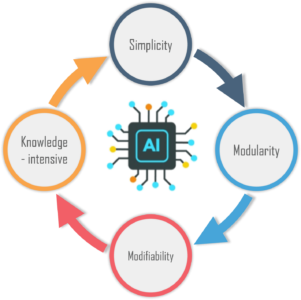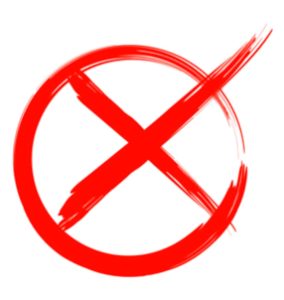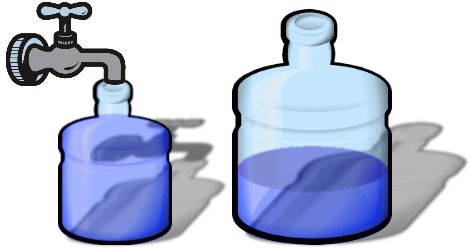Artificial Intelligence Certification Course
- 19k Enrolled Learners
- Weekend
- Live Class
A production system is based on a set of rules about behavior. These rules are a basic representation found helpful in expert systems, automated planning, and action selection. It also provides some form of artificial intelligence. In this article, we will talk about the production system in artificial intelligence in the following sequence:
Production system or production rule system is a computer program typically used to provide some form of artificial intelligence, which consists primarily of a set of rules about behavior but it also includes the mechanism necessary to follow those rules as the system responds to states of the world.
The major components of Production System in Artificial Intelligence are:
Global Database: The global database is the central data structure used by the production system in Artificial Intelligence.
Set of Production Rules: The production rules operate on the global database. Each rule usually has a precondition that is either satisfied or not by the global database. If the precondition is satisfied, the rule is usually be applied. The application of the rule changes the database.
A Control System: The control system then chooses which applicable rule should be applied and ceases computation when a termination condition on the database is satisfied. If multiple rules are to fire at the same time, the control system resolves the conflicts.
The main features of the production system include:

1. Simplicity: The structure of each sentence in a production system is unique and uniform as they use the “IF-THEN” structure. This structure provides simplicity in knowledge representation. This feature of the production system improves the readability of production rules.
2. Modularity: This means the production rule code the knowledge available in discrete pieces. Information can be treated as a collection of independent facts which may be added or deleted from the system with essentially no deleterious side effects.
3. Modifiability: This means the facility for modifying rules. It allows the development of production rules in a skeletal form first and then it is accurate to suit a specific application.
4. Knowledge-intensive: The knowledge base of the production system stores pure knowledge. This part does not contain any type of control or programming information. Each production rule is normally written as an English sentence; the problem of semantics is solved by the very structure of the representation.
In this 21st century, AI started replacing humans. AI is doing human activities like managing and accounting for finance in healthcare, transportation, etc. Then imagine how AI will be in the future. To know advancements in AI, Then you should have strong AI foundational knowledge. Enroll in our AI for Beginners course today!
How would you decide which rule to apply while searching for a solution for any problem? There are certain requirements for a good control strategy that you need to keep in mind, such as:
The first requirement for a good control strategy is that it should cause motion.
The second requirement for a good control strategy is that it should be systematic.
Finally, it must be efficient in order to find a good answer.
Production System rules can be classified as:
Deductive Inference Rules
Abductive Inference Rules
You can represent the knowledge in a production system as a set of rules along with a control system and database. It can be written as:
If(Condition) Then (Condition)
The production rules are also known as condition-action, antecedent-consequent, pattern-action, situation-response, feedback-result pairs.
There are four major classes of Production System in Artificial Intelligence:
Monotonic Production System: It’s a production system in which the application of a rule never prevents the later application of another rule, that could have also been applied at the time the first rule was selected.
Partially Commutative Production System: It’s a type of production system in which the application of a sequence of rules transforms state X into state Y, then any permutation of those rules that is allowable also transforms state x into state Y. Theorem proving falls under the monotonic partially communicative system.
Non-Monotonic Production Systems: These are useful for solving ignorable problems. These systems are important from an implementation standpoint because they can be implemented without the ability to backtrack to previous states when it is discovered that an incorrect path was followed. This production system increases efficiency since it is not necessary to keep track of the changes made in the search process.
Commutative Systems: These are usually useful for problems in which changes occur but can be reversed and in which the order of operation is not critical. Production systems that are not usually not partially commutative are useful for many problems in which irreversible changes occur, such as chemical analysis. When dealing with such systems, the order in which operations are performed is very important and hence correct decisions must be made at the first attempt itself.
Some of the advantages of Production system in artificial intelligence are:
Provides excellent tools for structuring AI programs
The system is highly modular because individual rules can be added, removed or modified independently
Separation of knowledge and Control-Recognises Act Cycle
The system uses pattern directed control which is more flexible than algorithmic control
Provides opportunities for heuristic control of the search
A good way to model the state-driven nature of intelligent machines
Quite helpful in a real-time environment and applications.
Now, let’s have a look at some of the disadvantages:
 It is very difficult to analyze the flow of control within a production system
It is very difficult to analyze the flow of control within a production system
It describes the operations that can be performed in a search for a solution to the problem.
There is an absence of learning due to a rule-based production system that does not store the result of the problem for future use.
The rules in the production system should not have any type of conflict resolution as when a new rule is added to the database it should ensure that it does not have any conflict with any existing rule.
Problem Statement:
We have two jugs of capacity 5l and 3l (liter), and a tap with an endless supply of water. The objective is to obtain 4 liters exactly in the 5-liter jug with the minimum steps possible.

Production System:
Solution:
1,8,4,6,1,8 or 3,5,3,7,2,5,3,5;
It is possible to have other solutions as well but these are the shortest and the 1st sequence should be chosen as it has the minimum number of steps.
With this, we have come to the end of our article on Production System in Artificial Intelligence. I hope you understood what is the production system and how it is used for controlling a global database easily.
To get in-depth knowledge, check out our interactive, live-online Edureka Python Data Science Certification Training here, that comes with 24*7 support to guide you throughout your learning period.
Got a question for us? Please mention it in the comments section of this “Cognitive AI” article and we will get back to you as soon as possible.
 Thank you for registering Join Edureka Meetup community for 100+ Free Webinars each month JOIN MEETUP GROUP
Thank you for registering Join Edureka Meetup community for 100+ Free Webinars each month JOIN MEETUP GROUPedureka.co